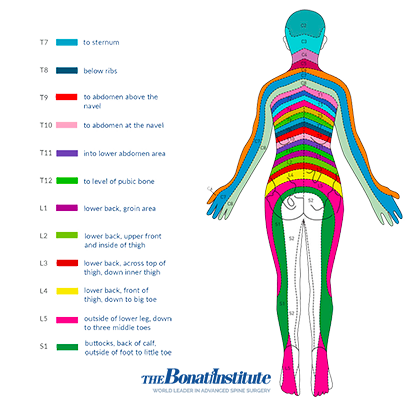The Bonati Institute Nerve Pathways help trace radiating pain back to its source in the spine.
Understanding Phantom Pain is often difficult to measure because the severity of the pain does not always reflect the severity of the injury. Some people feel extreme pain from relatively small injuries, while others show little or no pain even after suffering a severe injury. Pain can also be present even though no injury is apparent, or pain can linger long after an injury appears to have healed.
Understanding Pain Pain is both a physical and emotional experience caused by real or potential injury or damage to the body. It is often best described as a complex three-way warning system. First, acute pain warns of injury. Second, pain warns against further injury by causing the body’s movements to withdraw from the source of injury. Finally, pain leads to a period of reduced activity, enabling injuries to heal more efficiently.


Locating the Source of Neck Pain
You don’t have to learn to live with pain. If you have been experiencing headaches and/or a burning, numbness or pain radiating along any of these paths for more than 3-4 months, contact your medical practitioner.
Phantom Limb Pain
The term “phantom limb” was reportedly in 1871 by American neurologist Silas Weir Mitchell. Sir Mitchell described that “thousands of spirit limbs were haunting as many good soldiers, every now and then tormenting them”. However, in 1551, French military surgeon Ambroise Paré recorded the first documentation of phantom limb pain when he reported that, “For the patients, long after the amputation is made, say that they still feel pain in the amputated (missing) part”.
Phantom pain is a physical sensation an individual experiences relating to a limb no longer attached to the body. However, phantom limb sensations can also occur following issues with nerve avulsion or spinal cord injury. Phantom eye syndrome can occur after eye loss.
Sensations are recorded most frequently following the amputation of an arm or a leg, but may also occur following the removal of a breast, tooth, or finger(s). Phantom limb pain is the feeling of pain in an absent limb or a portion of a limb. The pain sensation(s) varies from individual to individual.
Phantom limb sensation is any sensory phenomenon (except pain) which is felt at an absent limb or a portion of the limb. It has been known that at least 80% of amputees experience phantom sensations at some time of their lives. Some experience some level of this phantom pain and feeling in the missing limb for the rest of their lives.
Notes on Phantom Limb Pain
Phantom limb pain, or pain that seems to come from the amputated limb, is a very real problem that you may face after an amputation. About 80% of people with amputations experience phantom limb pain that has no clear cause, although pain in the limb before amputation may be a risk factor.
Mirror therapy, where you perform exercises with a mirror, may help with certain types of phantom limb pain. Looking at yourself in the mirror simulates the presence of the amputated leg, tricking the brain into thinking it’s still there, stopping the pain.
In other cases, phantom limb pain might stem from another condition affecting the residual limb, such as sciatica or neuroma. Addressing these root causes can help eliminate the phantom pain.
How can I Reduce Phantom Pain?
How is phantom limb pain treated?
Treatment for phantom limb pain focuses on easing symptoms. They include:
- Nonsteroidal anti-inflammatory drugs (NSAIDs) or prescription pain relievers.
- Antidepressants.
- Antiseizure medications.
- Beta blockers.
- Muscle relaxers.
- Injections
Treatments that send electrical impulses to the nerves, brain or spinal cord may help ease the pain. These include:
- Neurostimulation.
- Spinal cord stimulation.
- Transcutaneous electrical nerve stimulation (TENS).
What is mirror therapy for phantom limb pain?
Studies suggest that mirror therapy can help ease phantom pain. During this therapy, you view the intact limb in a mirror while doing movement exercises for about 20 minutes a day. The reflection tricks the brain into thinking there are two healthy limbs.
Over time, the brain encodes this information. You may need to repeat the exercises for your pain to diminish. Since the brain doesn’t think the limb is missing, it doesn’t feel pain in the phantom limb. A physical therapist can help you master this exercise.
What other therapies help phantom limb pain?
These complementary therapies may also relieve phantom pain:
- Acupuncture.
- Biofeedback.
- Massage.
- Meditation or mindfulness exercises.
What are the complications of phantom limb pain?
Chronic phantom pain can harm your quality of life. It can also affect sleep. You may develop anxiety or depression. Medications and talking to a therapist can help.